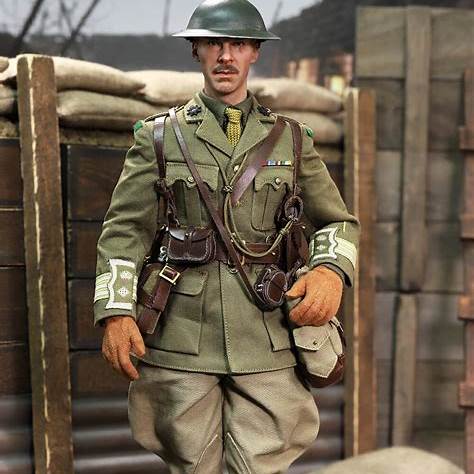
Types of British WWI Uniforms: A Detailed Guide to World War 1 Soldier Attire
Published on Mar 04, 2025
Types of British WWI Uniforms: A Detailed Guide
Introduction
World War I (1914-1918) witnessed one of the most significant shifts in military uniforms and warfare. The British Army’s uniforms were designed for function, protection, and practicality. Over time, these uniforms evolved due to battlefield experiences and technological advancements. This guide explores the different types of British WWI uniforms, detailing the distinctive elements that made them essential for soldiers.
The Standard British WWI Uniform
During World War I, British soldiers were primarily outfitted with the 1902 Service Dress—a uniform that reflected the transition from traditional military attire to more practical battlefield gear. Here are the core components of the British WWI uniform:
1. The Tunic
The British Army’s tunic was a khaki wool Service Dress tunic designed to blend with the environment and offer some insulation. It featured:
- Four large external pockets
- A high-standing stiff collar (later modified to a softer version for comfort)
- Brass buttons bearing the regimental insignia
- Epaulettes for rank identification
2. Trousers and Puttees
British soldiers wore matching wool trousers and wrapped their lower legs in puttees—long strips of cloth designed to protect against dirt, water, and minor injuries. These became a defining characteristic of WWI uniforms.
3. Headgear: The Brodie Helmet
Initially, British soldiers wore the Service Dress Cap, which provided little protection in trench warfare. 1916, the Brodie Helmet was introduced, offering better protection from shrapnel and debris.
4. Webbing and Equipment
The 1908 Pattern Webbing was a critical part of the soldier’s uniform, consisting of:
- Ammunition pouches
- Water bottle
- Bayonet frog
- Entrenching tool
- Haversack for carrying essentials This webbing system ensured soldiers had easy access to vital gear.
5. Footwear: Ammunition Boots
Soldiers were issued sturdy leather boots with hobnailed soles for better traction in muddy trenches. These boots were essential for endurance in harsh battlefield conditions.
Variations of British WWI Uniforms
Different branches of the British Army wore variations of the standard uniform based on their role and requirements.
1. Officer’s Uniform
Officers had distinct uniforms made of finer materials with tailored designs. They wore:
- Sam Browne belts
- Breeches instead of standard trousers
- Private purchase boots
- A peaked cap instead of a Brodie helmet (though helmets were used in combat)
2. Scottish Regiments
Scottish soldiers had unique uniforms that included:
- Kilts made from regimental tartan patterns
- Spats over their boots
- Glengarry or Tam o’Shanter caps instead of standard helmets
3. Specialized Units
Certain divisions had modifications to their uniforms:
- Tank Corps wore leather helmets to protect against head injuries inside tanks.
- Machine Gun Corps received extra padding in their uniforms.
- Gas mask carriers became standard after the introduction of chemical warfare.
The Influence of British WWI Uniforms on Other Armies
The United States Army adopted elements of British military attire during WWI. The U.S. WWI uniform shared similarities, including:
- Olive drab woolen tunics and trousers
- Leather puttees
- Steel helmets similar to the Brodie design
- The British system influenced webbing. These influences highlight how British innovations in military clothing shaped modern warfare attire.
The Legacy of WWI British Uniforms
The practical design of British WWI uniforms laid the groundwork for future military attire. Many features, like khaki colour schemes, standardized webbing, and protective helmets, carried forward into WWII British soldier uniforms and beyond.
Conclusion
British WWI uniforms were more than just attire—they were an integral part of military strategy, offering camouflage, protection, and utility. Every piece played a role in a soldier’s survival, from the Service Dress tunic to the Brodie helmet. These uniforms remain significant in military history and are still studied, collected, and admired by enthusiasts worldwide.
For those interested in historical uniforms, understanding the nuances of WW1 British soldier uniforms provides a fascinating glimpse into the evolution of military gear. Whether you are a collector, historian, or enthusiast, these uniforms tell the story of courage and innovation in the trenches of World War I.
